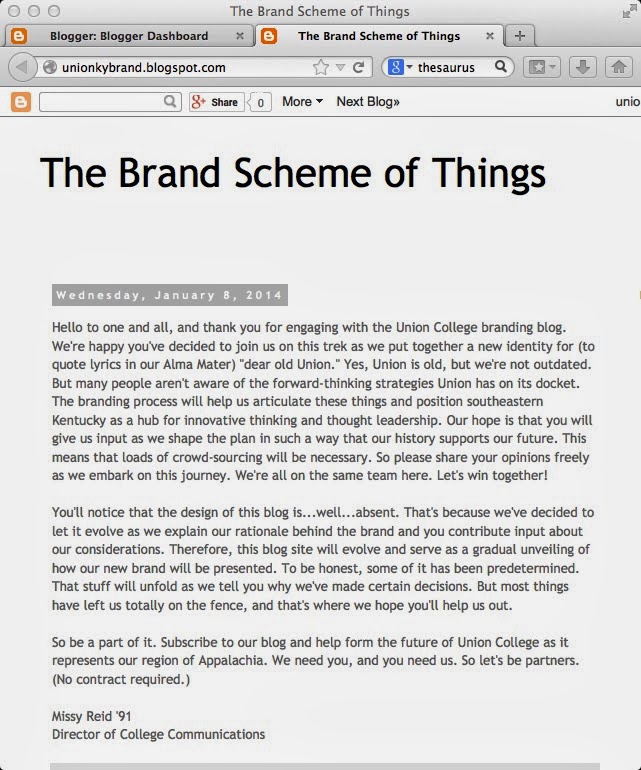Are fonts important to a brand identity? You betcha. They
shouldn’t be chosen on a whim, as they are as important to the identity system as
colors and photography style in creating a unified look, while inspiring an
intended emotional response. Further, the system should visually communicate how
a brand is different from its competitors. To say this is much to consider is
an understatement. But we’re on it.
So how do fonts participate in the identity system to
illustrate our story? Think about your dinner table. Our third meal of the day
is a routine part of life, but sometimes the centerpiece is a pizza box
surrounded by paper plates on Hot-N-Ready night (rhetorical pop quiz: Which
brand am I referring to here?), while on rare occasions, the centerpiece is fresh
flowers in a crystal vase surrounded by fine china and linens. Regardless of
the entrée or the presentation, it’s still dinner. But the presentation is key
in defining the mood and often the behavior of the people engaging with it. So
it is with fonts. They communicate words. The language (like the entrée) paired
with certain fonts (like the table settings) influences how people perceive a
brand. And if they aren’t coupled in a way that makes sense, credibility can
suffer. Imagine being invited to a formal dinner with take-out pizza as the
main course. The conflict would be tough to reconcile, would it not? (But not
impossible, in my view. It might actually be fun, but you get the picture.)
 OK, so my analogy makes common sense, but naysayers may
need real-world evidence, so here you go: The European Organization for Nuclear
Research (CERN) released an important discovery in the summer of 2012 about how
atoms stick together. This physics project was expensive and globally
significant, but the public had a difficult time taking it seriously because
scientists used Comic Sans MS to present their research. Instead of being in
awe, the mainstream public made a joke out of it. Is the mainstream public
superficial? Perhaps. But that’s really irrelevant. We’re not on a mission to
convince them to pay attention to content rather than presentation; we’re
campaigning to influence their perception. That means we must pay attention to
what influences them. And fonts do that.
OK, so my analogy makes common sense, but naysayers may
need real-world evidence, so here you go: The European Organization for Nuclear
Research (CERN) released an important discovery in the summer of 2012 about how
atoms stick together. This physics project was expensive and globally
significant, but the public had a difficult time taking it seriously because
scientists used Comic Sans MS to present their research. Instead of being in
awe, the mainstream public made a joke out of it. Is the mainstream public
superficial? Perhaps. But that’s really irrelevant. We’re not on a mission to
convince them to pay attention to content rather than presentation; we’re
campaigning to influence their perception. That means we must pay attention to
what influences them. And fonts do that.
So what kind of fonts will appropriately tell Union’s
story? In answering this question, we had many things to consider. For one, we
had to look at our competitors so we wouldn’t have typefaces that could be
confused with theirs. Differentiation is key to building a successful brand,
right? Also, we had to think about the general message we want to send. Based
on our marketing research, along with Union’s vision and mission, it makes
sense for us to promote a brand based on strong social responsibility that
resonates with connected consumers. (By “connected,” we mean those whose
day-to-day experiences with friends, influencers and brands include many online
touch points. More on that later.) And to communicate effectively with our
target market, we must consider what’s important to students in our region of
Appalachia. This part is easy, because the things that are important to them
are in perfect alignment with what’s important to us: We all want to positively
influence a change in the perception that many people have of southeast
Kentucky. To erase a stereotype based on “Mountain Dew mouth” and other
not-so-attractive beliefs, we must assert ourselves as confident thought
leaders and contribute to the economic growth of our area.
So what kind of font communicates confidence, focus,
determination and forward thinking? We think Museo is an excellent choice for
this. But it’s not perfect.
Museo is the typeface you see in the blog title. It’s also
overused. Google it, and you’ll so what I mean. Problematic? Yes. But we think
we can work around it by modifying the presentation to make it more unique. We
plan to use it as a display font, which means it will be used sparingly. More
about that tomorrow.
For now, I’d like to draw your attention to another font
we’ve chosen to help us communicate a brand that exudes confidence and forward
thinking: Optima. Unlike Museo, this font isn’t new or trendy, but it’s
appropriate.
Thank you for reading, and please comment about how you
think we could graphically modify Museo to create a unique headline for Union’s
marketing messages.
 And in the future, if you're concerned about colors or any other aspect of the new brand, please don't be afraid to post questions or comments here. That's what this blog is for...at least for now. Eventually, the purpose will shift to how we should live the brand and sustain it.
And in the future, if you're concerned about colors or any other aspect of the new brand, please don't be afraid to post questions or comments here. That's what this blog is for...at least for now. Eventually, the purpose will shift to how we should live the brand and sustain it.




